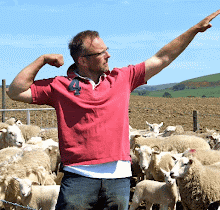Warning: The following post contains constant and detailed reference to sheep and should not be read by those with a low tolerance to sheep chat ....
Three days back and its all been a bit bonkers here. The reality is that I owe people money, which I didn’t when I left for my trip. Six weeks of not doing consultancy and cash flow has stopped - one of the rules of first generation farming club I learnt whilst away was that Cash is King..... Bugger - I’m breaking the rules already.
In a vain attempt to stop the men with baseball bats coming to make enquiries, I sent 40 lambs too market on Thursday. The results made me think:

To make a fair comparison, lets use the price per kg figure and then make both the first two groups 40 kg lambs instead. Per head, the Wiltshire crosses would have been £63.60; the Texel crosses would have been £68.40 - that’s almost £5 of a difference. On this basis, taking an example of a total of 650 lambs sold, that would be £3,120 more income if they were all texel lambs. To make this difference up I’d need 699 Wilt cross lambs to produce the same income as just 650 texel crosses.
On the evidence of the above, I probably should be happy to drop the Wiltshire and just use Texel rams ..... but I can’t. See, once upon a time, I had this plan to breed my own peculiar composite ewe. It would shed its wool (that’s why I needed the Wiltshire), be prolific, a great mum and have good conformation. One day I would have thousands of these perfect sheep. I believe in fairy tales - I’m a dreamer and a romantic - but it’s the hope this plan might actually work in reality that makes me happy.
The lambs in the first group were either 62.5% or 56.25% Wilt (its less complex than it sounds, honest!) but only 12.5% or 7.25% Texel (Ok not doing myself any favours re the complexity argument, am I?). The end aim for the composite sheep is for them to be Wilt 50%, Texel 25% and Lleyn 25% with most of them producing Texel sired lambs. I’ll get good prices with patience. I just need to endure some pain before I experience the pleasure. It will all end happily ever after - honest!





















